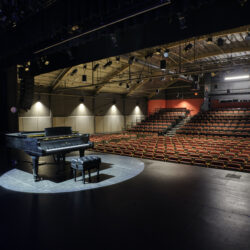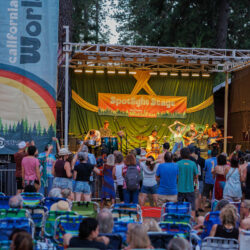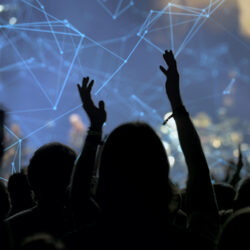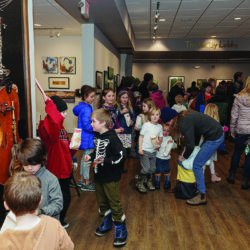Susan Rogers: Hear! Hear! for Center for the Arts new hearing loop system
Columns | November 1, 2019
Link to original story.
Columnist, The Union
Attention everyone who has some hearing loss! The renovated Center for the Arts will be offering the best technology now available for providing a better listening experience in a public venue: the hearing loop and telecoil system.
What’s a hearing loop and how does it work? The system uses a wire loop, or series of loops, installed around the perimeter of a room, usually in the floor or under the carpet. Large venues may have multiple loops.
When someone speaks or sings into a microphone that is plugged into a loop-connected amplifier, the sound is delivered to the loop, which creates a magnetic field around the room.
Audience members who wear hearing aids with a telecoil (also called a T-coil) can switch it on and hear the speaker or performer as clearly as if they were listening through headphones. Those who don’t have a T-coil in their hearing aid (or who have some hearing loss but don’t yet have hearing aids) can use a provided set of headphones and a receiver to listen through the loop.
For people with hearing loss, the effect is profound. The sound goes directly from the microphone(s) into the person’s hearing aids, instead of traveling through the room’s background noise, bouncing off walls and other objects, and competing with nearby conversations. Where hearing loops are present, a listener’s telecoil-equipped hearing aids become personal, high-quality speakers.
The potential for hearing loops to increase the quality of life for an aging population is huge. More than 48 million people in the United States have hearing problems, according to the Center for Hearing and Communication.
This is why the New York subway system has installed hearing loops at numerous subway booths, greatly improving the interactions between agents and hard-of-hearing passengers.
Europe is far ahead of the U.S., installing hearing loops in Westminster Abbey and other houses of worship, college lecture halls, theaters, concert venues, post offices, tourist attractions, businesses and other sites, AND taxis. Hearing loops can be found in some American venues, but to a much lesser degree.
Here in Nevada County, our large senior demographic means we have a greater-then-average portion of our population with hearing loss. But it’s not just an old folks’ problem. Audiologists know that young people are experiencing hearing loss because they don’t protect their hearing from loud noises such as leaf blowers or rock bands, or because of excessive volume on earphones.
The telecoil is not new technology – it was invented for use in hard-wired telephone handsets. For that reason, telecoils are dismissed by some who think Bluetooth, FM or infrared are somehow better technologies simply because they are newer. But research and experience have proven again and again that in public and personal spaces (such as one’s living room or car), hearing loops and telecoils provide a vastly superior hearing experience.
One caveat: your hearing aid must have a telecoil to receive the signal from the hearing loop. About 80% of hearing aids sold have a telecoil, but audiologists typically don’t talk about them with their customers because so few venues in the U.S. are looped. You should call and ask if your hearing aids have a telecoil, and if so, a visit to your audiologist is needed to activate it and receive instructions on how to turn it on when needed. For patrons whose aids don’t have a telecoil, the Center will provide a set of headphones and a receiver.
The Center for the Arts is to be congratulated for choosing to invest in hearing loop technology to provide the best possible experience for its patrons. Watch the pages of this newspaper for a story and photos about the installation. And talk about supporting local business – the installer is licensed contractor Jeff Klus, whose Grass Valley company (www.copperloop.net) has installed hearing loops in dozens of buildings in Northern California. All BART station agent booths in the Bay Area now have these systems.
The Center will be the second venue in Nevada County to get a hearing loop – kudos to the City of Grass Valley for already having a hearing loop in its Council Chambers. Can we match the efforts of places like Eugene, Oregon and Albuquerque, New Mexico, by forming a local committee to advocate for hearing loops in many more public spaces around here? The “Loop Eugene” committee has a spreadsheet of all the concert venues, government council rooms, churches and other public spaces, tracking whether or not they are looped. (Many Eugene churches have been looped with funding provided by their parishioners after they learn that a loop will allow them to hear the sermons again.)
If this all sounds intriguing to you and you would like more information, please contact me through the email address at the end of this piece. My goal is to find people who will form a committee and “drive” the effort to both educate our local population and advocate for hearing loops in other locations (think Veterans Memorial Building in Grass Valley and Supervisor’s chamber at the Rood Center). Hope to hear from you.
Susan Rogers is a member of The Union’s Editorial Board. Her opinions are her own and do not necessarily reflect those of the editorial board or its members. She can be reached at editboard@theunion.com.
–
Original Article: https://www.theunion.com/opinion/columns/susan-rogers-hear-hear-for-center-for-the-arts-new-hearing-loop-system/




